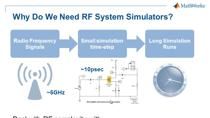Design and Analysis of Industry Standard High-Speed Serial Links
From the series: MathWorks Wireless Series: Transforming the Next Generation of Wireless Communication
Overview
In today's high-speed communication systems, analyzing the specific properties of the high-speed links is quite challenging.
In this talk, you will learn how to analyze and apply techniques for high-speed serial links using Signal Integrity Toolbox. You can predict operating margins and link performance by analyzing transmitter, receiver, and channel interactions.
Also, you will learn how to integrate existing SerDes interfaces and minimize signal integrity issues. You can analyze the performance of high-speed serial and parallel links such as Ethernet, PCIe, USB, DDR, when connected to different channels.
Highlights
- Channel analysis performed in the time and frequency domains.
- Design and verification of high-speed links using IBIS-AMI models generated with SerDes Toolbox.
- Automation and management of large sets of models, testcases, simulation results enabling design space exploration.
- Post-layout channel models extracted with RF PCB Toolbox.
- Perform root-cause analysis of signal integrity issues caused by the PCB on the high-speed link performance.
About the Presenter
Jahnavi Dhulipala is an Application Engineer at MathWorks, India specializing on Mixed Signal, Serdes and Signal Integrity designs. She works closely with customers across domains to help them adopt MATLAB® and Simulink® in their workflows. Prior to joining MathWorks, she worked for ISRO as a Research Fellow designing and implementing RF transceivers. She is currently pursuing her doctoral research in Information and Communication engineering and holds a master’s degree in Applied Electronics from Anna University.
Recorded: 29 Jun 2022





